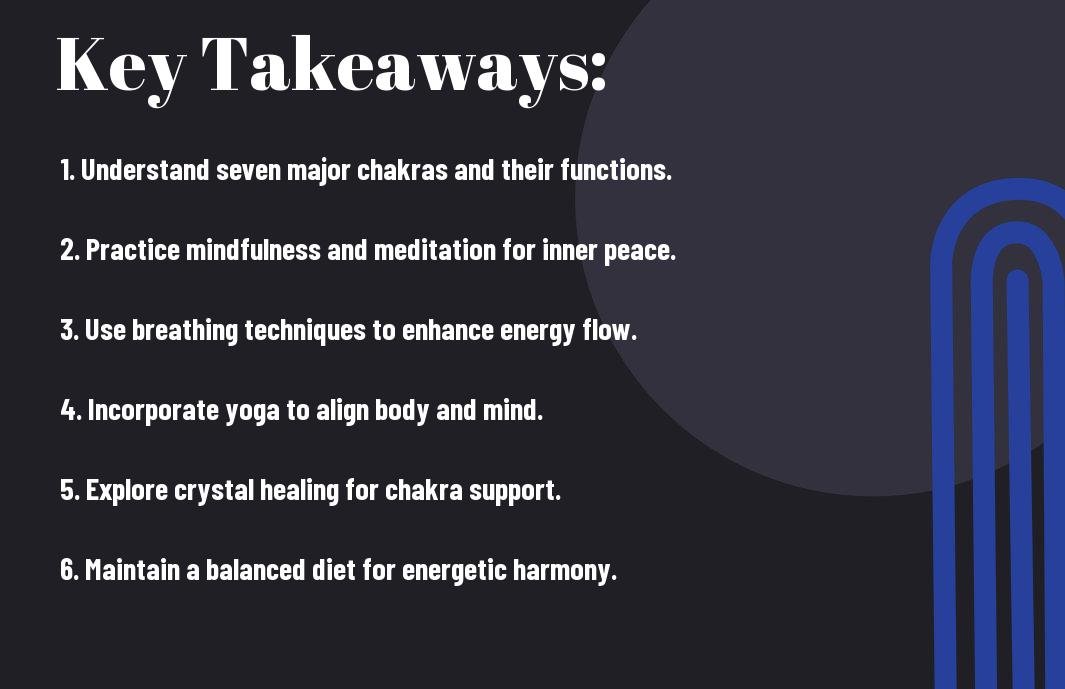A Path To Emotional Stability And Sensitivity With Chakra Balancing!
Just by understanding chakra balancing, you can unlock a pathway to emotional stability and enhanced sensitivity. Your chakras are the energy centers in your body, and when they become blocked or unbalanced, it can lead to emotional turmoil and physical discomfort. In this blog post, you will discover practical techniques to help you realign your chakras, fostering a sense of harmony and well-being. Embrace this journey to deepen your awareness of how your emotional landscape interacts with your energetic self, ultimately paving the way for a more balanced life.

Key Takeaways:
- Understanding Chakras: Familiarize yourself with the seven main chakras and their associated emotions and physical functions to identify areas needing balance.
- Mindfulness Practices: Incorporate mindfulness techniques, such as meditation and breathwork, to help enhance awareness of your emotional state and align your chakras.
- Energy Healing: Explore modalities like Reiki or acupuncture that can help release blocked energy and promote chakra stability.
- Healthy Lifestyle Choices: Adopt a balanced diet, regular exercise, and sufficient sleep to support overall wellness and chakra harmony.
- Color Therapy: Utilize the colors associated with each chakra through clothing, art, or visualization to foster emotional healing and balance.
- Aromatherapy: Use crucial oils specific to each chakra to enhance energy flow and promote relaxation and emotional stability.
- Intention Setting: Practice setting intentions and affirmations focused on emotional stability to reinforce your journey towards chakra balancing.
Understanding Chakras
As you initiate on your journey toward emotional stability and sensitivity, it is vital to first grasp the concept of chakras. These are the energy centers within your body that influence various aspects of your physical, emotional, and spiritual health. The word “chakra” comes from the Sanskrit term meaning “wheel” or “disk,” and they can be visualized as spinning vortexes of energy. Each chakra corresponds to specific emotional states and physical functions, making them integral to your overall well-being. When your chakras are aligned and balanced, you will likely experience harmony within yourself, but when they become out of balance, it can lead to emotional instability and other challenges in your life.
The Seven Major Chakras
One of the most foundational aspects of understanding chakras is recognizing the seven major ones that facilitate your energy flow. These chakras are positioned along your spine, beginning at the base with the Root Chakra and extending to the crown of your head with the Crown Chakra. The Root Chakra is associated with feelings of safety and grounding, while the Sacral Chakra governs your emotions and creativity. Moving up the spine, the Solar Plexus Chakra is linked to personal power; the Heart Chakra connects to love and compassion; the Throat Chakra encompasses communication; the Third Eye Chakra relates to intuition; and finally, the Crown Chakra represents spiritual connection. Each energy center plays a vital role in your emotional and physical states.
Understanding these seven major chakras allows you to identify areas where you may feel out of balance or blocked. This awareness is the first step in your journey to re-establish emotional stability and sensitivity, helping you navigate through life’s ups and downs with greater ease.
The Role of Chakras in Emotional Well-Being
With an understanding of chakras, you can appreciate their significant role in your emotional well-being. Each chakra not only governs its unique emotional landscape but also affects how you interact with the world around you. For instance, when your Heart Chakra is balanced, you are more likely to express love and compassion, but if it becomes blocked, you may find it difficult to connect emotionally with others. This interdependence means that a blockage in one chakra can ripple through the others, leading to heightened feelings of anxiety, frustration, or sadness.
Seven critical emotional states can be influenced by your chakras: feelings of safety, sexual expression, personal power, love, communication, intuition, and spiritual connectedness. Each of these states, when in harmony, not only promotes positive emotional health but also enhances your ability to empathize and connect with others on a deeper level. By actively working towards chakra balancing, you empower yourself to cultivate emotional resilience and sensitivity that enriches your life.
Signs of Chakra Imbalance
It is necessary to recognize the signs of chakra imbalance as they can significantly affect your emotional and physical well-being. Each chakra corresponds to specific emotional states, and detecting disruptions can help you identify areas of your life that may need attention. When your chakras are not balanced, it can lead to feelings of unease, anxiety, or negativity, impacting your overall emotional health. Monitoring your feelings and emotional responses allows you to pinpoint which chakra might need realignment, aiding you on your path to stability and harmony.
Emotional Indicators
By being attuned to your emotions, you can gain insight into potential chakra imbalances. For example, if you find yourself experiencing persistent feelings of fear, insecurity, or low self-esteem, this could signal a blockage in your root chakra. Conversely, if you encounter overwhelming emotional sensitivity, such as excessive mood swings or an inability to express your feelings, your heart chakra might be involved. These emotional indicators can serve as a guide to help you initiate on the healing journey necessary for restoring balance in your chakras, ultimately leading to greater emotional stability.
Physical Indicators
Emotional turmoil frequently manifests in physical symptoms, which can be a clear sign of chakra imbalance. You may experience chronic fatigue, digestive issues, or unexplained pain, often correlating with the specific chakra that is out of alignment. For instance, a disconnected throat chakra might result in sore throats or neck pain, while an unbalanced solar plexus chakra could lead to gastrointestinal discomfort. Being aware of these physical indicators is vital, as they can direct you toward the necessary steps for healing and restoration.
But it is necessary to understand that not all physical symptoms are directly linked to chakra imbalances. Your body’s signals can also arise from emotional stress, daily lifestyle choices, or even nutritional deficiencies. It is highly recommended to observe these physical indicators and evaluate them in the context of your emotional state and lifestyle to gain a clearer understanding. Engaging in practices that promote chakra alignment can pave the way for both emotional and physical healing, leading to a more balanced and enriched life.
Techniques for Chakra Balancing
After understanding the role that chakras play in your emotional well-being, it’s time to explore practical techniques that can help you achieve chakra balancing. The journey toward emotional stability and heightened sensitivity involves various practices that you can incorporate into your daily routine. Among these techniques, meditation and mindfulness stand out as powerful tools for nurturing your energy centers and reconnecting with yourself.
Meditation and Mindfulness
An effective way to tune into your chakras is through meditation and mindfulness practices. By setting aside a few quiet moments each day, you can focus on your breath, visualize the colors associated with each chakra, and cultivate a sense of awareness that enhances your emotional stability. This intentional awareness allows you to observe any blockages or imbalances, which is the first step towards healing and aligning your chakras.
Yoga and Movement Practices
Movement is another crucial component of chakra balancing that encourages energy flow throughout your body. Engaging in yoga or other movement practices can help you connect with your physical self and release any stagnant energy that may be affecting your emotional health. Specific postures target individual chakras, allowing you to bring attention to areas that may need extra care. As you flow through your practice, focus on deep, intentional breathing to amplify the effects of your movements.
Yoga can be particularly effective for chakra balancing due to its combination of physical postures, breathwork, and meditation. Each position can stimulate and open various energy centers, promoting a sense of well-being and emotional release. As you practice regularly, you may notice a shift in your overall mood, enhanced sensitivity to your emotional states, and a renewed sense of connection to your inner self. By maintaining consistent yoga practice, you empower yourself to navigate life’s challenges with greater stability and emotional resilience.
The Role of Nutrition in Chakra Balance
Unlike common perceptions that focus solely on physical practices such as yoga and meditation for achieving chakra balance, your nutrition plays a significant role in your emotional stability and sensitivity. Proper nourishment can help you to maintain a clear and vibrant energy flow through your chakras, thus enhancing their function. Integrating specific foods that resonate with each chakra can assist you in addressing imbalances and promoting overall wellness, helping you to align with your emotional and spiritual goals.
Foods for Each Chakra
With an understanding of the different chakras, you can tailor your diet to include foods that correspond to each energy center. For example, red foods like beets and tomatoes can stimulate the root chakra, grounding you and providing stability. Orange foods such as carrots and sweet potatoes are beneficial for the sacral chakra, enhancing creativity and emotional expression. As you progress through the chakras, yellow foods like bananas and corn can energize the solar plexus, green foods such as spinach and kale can support the heart chakra, and blue foods like blueberries can promote peaceful communication within the throat chakra.
Herbal Remedies and Supplements
Behind every chakra lies the potential for imbalance, which can often be mitigated by incorporating herbal remedies and supplements. Natural herbs such as ashwagandha and rhodiola are known to help reduce stress and anxiety, supporting the balance of your root and solar plexus chakras. Meanwhile, herbs like lavender and chamomile can promote calmness and relaxation, enhancing the energy flow through your heart and throat chakras. These remedies can serve as powerful allies in your journey towards emotional stability, enabling you to better respond to life’s challenges.
Chakra balancing through herbal remedies can also include supplements like omega-3 fatty acids, which support brain health and emotional resilience. You might find that certain vital oils, such as eucalyptus and sandalwood, also resonate with specific chakras when used in aromatherapy. However, it’s important to consult with a healthcare professional before introducing new supplements into your routine, as some may interact with your current medications or conditions. By thoughtfully integrating these natural aids into your lifestyle, you can elevate your chakra balancing practices and promote greater emotional wellbeing.

Energy Healing Practices
For anyone seeking to achieve chakra balancing and enhance emotional stability, energy healing practices can be transformative.
These methods focus on the flow of energy within your body and help alleviate blockages that may affect your mental and emotional well-being. By integrating practices such as Reiki, Pranic Healing, and Crystal Healing into your routine, you can cultivate a harmonious balance in your energy centers, leading you to a healthier state of mind.
Reiki and Pranic Healing
Above all, Reiki and Pranic Healing are two popular forms of energy healing that aim to clear energy blockages and promote emotional healing. Reiki involves the gentle laying on of hands to transfer universal energy to the recipient, facilitating deep relaxation and emotional release. In contrast, Pranic Healing works with the subtle energy that surrounds and permeates your body. This technique helps in cleansing and invigorating your energy field, which can help significantly in maintaining emotional stability.
Crystal Healing
Healing with crystals is another effective energy healing practice that you may find valuable in your chakra balancing journey. By harnessing the unique vibrational energies of different crystals, you can positively influence your emotional state. Placing specific crystals on corresponding chakra points encourages energy flow and aligns your emotional landscape. For instance, amethyst can help calm your mind and promote tranquility, while carnelian may boost your motivation and creativity.
Practices involving crystal healing can be incredibly rewarding and empowering as you work to balance your chakras. You may choose to carry crystals with you, meditate with them, or place them in your living space to enhance their effects. It’s imperative to select high-quality crystals and cleanse them regularly to eliminate any negative energies they may accumulate. By incorporating these practices into your daily life, you can foster a deeper connection with your emotions while promoting a stable and sensitive approach to your overall well-being.

Creating a Supportive Environment
Not only is your internal state vital for achieving chakra balancing, but the environment you inhabit plays an equally significant role. A harmonious and nurturing space can greatly enhance your emotional stability and sensitivity. This means assessing the physical aspects of your environment, such as colors, lighting, and arrangements that resonate with the energy you wish to cultivate. Introducing elements that inspire peace, clarity, and vibrant energy can reinforce your intentions, making it easier to connect with your chakras and maintain balance in your everyday life.
Feng Shui and Space Clearing
After you decide to create a supportive environment, incorporating Feng Shui principles and engaging in regular space clearing can be transformative. Feng Shui is the ancient Chinese practice of arranging your space to promote positive energy flow, while space clearing involves removing stagnant energy. By ensuring your home is clutter-free and thoughtfully designed, you can enhance the movement of chi, or energy, in your living area, which directly impacts your emotional and spiritual health. Consider using items like plants and mirrors strategically to allow light and life to flow through your space, bringing vibrations that align with your goals for chakra balancing.
Sound Healing and Music Therapy
By incorporating sound healing and music therapy into your life, you can enhance your emotional well-being and facilitate chakra balancing. Both modalities harness the power of sound frequencies to promote healing and alignment throughout your body. Different sound waves, such as those produced by singing bowls, tuning forks, or even ambient music, can resonate with the specific vibrations of your chakras, encouraging blockages to release and energy to flow freely. Furthermore, engaging in music therapy can help you express emotions that might be difficult to verbalize, allowing you to process feelings and restore balance more effectively.
Another aspect of sound healing and music therapy is the therapeutic effects of listening to music or sounds that resonate with your chakras. For instance, you may choose to play instrumental tracks that are specifically composed for chakra balancing, as they are designed with the proper frequencies to evoke emotional release and inner peace. Whether through participation in sound baths, creating playlists of your favorite calming tunes, or using sound-based meditation apps, these practices can significantly enhance your journey towards emotional stability and sensitivity. Engaging regularly with sound healing will help maintain your energy balance, keeping you attuned to your needs and emotions.

Summing up
Summing up, achieving chakra balancing is an empowering journey towards enhancing your emotional stability and sensitivity. By understanding the seven primary chakras and their associated energies, you can develop a deeper connection with yourself and become attuned to your emotional needs. Engaging in practices such as meditation, yoga, and breathwork allows you to align these energy centers, fostering a sense of peace and clarity in your life. Tailoring your approach to your unique experiences will enable you to navigate your emotional landscape more effectively.
Additionally, incorporating tools like crystals, necessary oils, and affirmations into your daily routine can further support your efforts toward balancing your chakras. As you explore these techniques, be patient with yourself, as each individual’s journey is distinct. Embracing the path of chakra balancing ultimately empowers you to cultivate emotional resilience, enrich your sensitivity to others, and live a more balanced, harmonious life. Your commitment to this practice not only strengthens your well-being but also enhances your interactions with the world around you.
FAQ
Q: What are chakras and why are they important for emotional stability?
A: Chakras are energy centers in the body that influence various aspects of physical, emotional, and spiritual well-being. There are seven primary chakras, each corresponding to different emotional states and life experiences. When these energy centers are balanced, individuals often experience enhanced emotional stability, reduced stress, and a better capacity to navigate life’s challenges with sensitivity and resilience.
Q: How can I identify if my chakras are out of balance?
A: Signs of unbalanced chakras can manifest in various ways. Emotional symptoms may include feelings of anxiety, anger, or sadness, while physical symptoms can present as fatigue, tension, or illness. Each chakra corresponds to specific issues; for instance, if you feel inadequate socially, it might indicate a blockage in the heart chakra. Keeping a journal to track your emotions and physical sensations can help you identify imbalances.
Q: What methods can be used for chakra balancing?
A: There are several methods to achieve chakra balancing, including meditation, yoga, breathwork, sound healing, and the use of crystals. Meditation helps in focusing energy and calming the mind, while yoga poses are designed to open and activate the chakras. Crystals like amethyst and rose quartz can support energy flow, and sound healing can restore balance through vibrations.
Q: How can meditation help in balancing my chakras?
A: Meditation is an effective practice for chakra balancing as it encourages awareness of bodily sensations and emotional states. Focusing on each chakra during meditation allows individuals to visualize and channel healing energy to areas that feel blocked. Techniques can include guided meditations, chanting specific sounds associated with each chakra, or simply spending time in silence, concentrating on breath and inner feelings.
Q: What role does yoga play in achieving chakra balance?
A: Yoga is a powerful tool for chakra balancing as it combines movement, breath control, and mindfulness. Specific poses target different chakras, promoting energy flow and alleviating stagnation. For instance, poses such as the Warrior or Tree pose can enhance the root chakra’s grounding energy, while heart-opening poses like Cobra can help in activating the heart chakra.
Q: Can diet and lifestyle choices impact chakra balancing?
A: Yes, diet and lifestyle choices can significantly influence chakra health. Eating a diverse and balanced diet rich in fruits, vegetables, and whole grains supports physical health and energy flow. Additionally, lifestyle choices that promote well-being, such as regular exercise, sufficient sleep, and healthy relationships, can create a supportive environment for maintaining balanced chakras.
Q: How long does it take to achieve chakra balancing?
A: The time it takes to achieve chakra balancing varies for each individual depending on their level of awareness, commitment to practices, and emotional history. Some may feel immediate effects after a session of yoga or meditation, while others may find that a sustained practice over weeks or months is necessary to fully experience emotional stability and sensitivity. Consistency and patience are key elements in this journey.








0 Comments